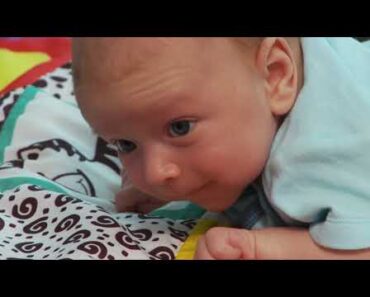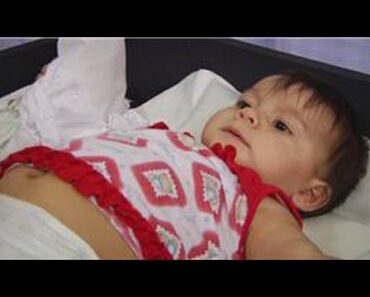image: Shutterstock
Harlequin ichthyosis (HI), also called a harlequin fetus or harlequin-type ichthyosis, is a rare, severe genetic disorder affecting the skin. Babies with this condition may have thick and hard skin over the body from birth. The skin can be covered with diamond-shaped plates resembling fish scales with deep fissures separating them.
Read this post to know about the causes, clinical features, complications, treatment, and outcome of harlequin ichthyosis in babies.
Causes Of Harlequin Ichthyosis
Mutations in the ABCA 12 gene cause harlequin ichthyosis. This mutation is inherited in the autosomal recessive pattern. ABCA 12 gene encodes a transporter protein required to transport epidermal lipids across the cell membrane for normal skin development (1).
Loss of function of ABCA12 protein disrupts normal skin (epidermal) development, causing thick and hard scales on the skin.
Who Gets Harlequin Ichthyosis?
Harlequin ichthyosis is rare, affecting approximately one in 300,000 newborns. There is no specific racial or geographic prediction known for this condition. Both males and females are equally affected. However, cultures with consanguineous marriages (marriage between close relatives) may have a higher incidence
(2).
In consanguineous marriages, both the mother and father could be silent carriers of the same autosomal recessive condition. Therefore, the risk of developing the genetic disorder is higher for their children.
Signs And Symptoms Of Harlequin Ichthyosis
The following cutaneous (skin) features are seen in babies with harlequin ichthyosis (3).
- Skin issues are present at birth
- Thick and large skin
- Plates of shiny hyperkeratotic scales
- Deep erythematous fissures separating the scales
Facial features may include the following.
- Poorly developed nose with obstructed nostrils, eroded nasal alae (wing of the nose), and nasal hypoplasia
- Severe ectropion (outward turning of the eyelid) that may increase the risk of dryness, trauma, and infection of conjunctiva and cornea
- Eclabium (outward turning of lips) can be caused by lip traction
- Absent or poorly developed ears may appear flattened
- Scales may obstruct the external auditory canal (outer ear canal)
Clinical features on extremities may include the following.
- Extra fingers and toes
- Hypoplasia of digits (fingers and toes)
- Limbs may be encased in thick skin
Thickened skin may cause thermal dysregulation, which may lead to the following clinical features.
- Altered sweat gland function and heat loss mechanism due to thick skin may cause increased body temperature and heat stroke
- Dehydration due to excess fluid loss
Doctors may order specific diagnostic tests to exclude the diagnosis of less severe conditions that may have similar signs and symptoms.
Complications Of Harlequin Ichthyosis
The following complications are commonly seen in babies with harlequin ichthyosis (3).
- Life-threatening infections: Disruption of normal skin barriers may occur due to skin abnormalities. This may make the skin vulnerable to infections.
- Respiratory issues: Rigid skin may interfere with chest wall expansion and often result in hypoventilation and respiratory failure.
- Muscle shortening and limb constriction: Thickened skin may cause contractures or muscle shortening near the joints. Limbs, including the fingers and toes, can also be constricted, resulting in necrosis, swelling, and autoamputation.
Diagnosis Of Harlequin Ichthyosis
Physical examination and genetic testing may help to diagnose harlequin ichthyosis in babies. Genetic testing for loss of function mutation of the ABCA12 gene is the most specific diagnostic test. Sometimes, doctors may also order skin biopsies. Thickened outer layers of skin and other histological changes may help identify the condition.
Additional tests are often ordered to look for complications and differentiate medical conditions with similar clinical features.
Differential Diagnosis For Harlequin Ichthyosis
Differential diagnosis is a process in which doctors differentiate various medical conditions behind the symptoms present. The possibilities of the following conditions are ruled out through genetic testing while diagnosing harlequin ichthyosis (4).
1. Inherited ichthyoses
Various congenital and delayed onsets of inherited ichthyoses are seen in babies. These are caused by different mutations and account for approximately 95% of ichthyosis cases. Some of the clinical features of these conditions can be similar to harlequin ichthyosis.
i. Ichthyosis vulgaris
95% of ichthyosis can be due to ichthyosis vulgaris. This is due to a mutation in the gene encoding filaggrin (FLG) proteins. FLG is required to bind keratin fibers in the epidermal cells to form skin barriers. They help maintain skin pH, prevent trans-epidermal water loss, and moisten the skin.
Skin dryness (xerosis) and skin lines in palms and soles are commonly seen in ichthyosis vulgaris. Eczema is seen in most babies with this condition, and they also have a high risk of developing asthma and rhinitis later in life. In some infants, onset may be delayed until three months of age.
ii. Recessive X-linked ichthyosis
Recessive X-linked ichthyosis occurs due to mutation of the steroid sulfatase (STS) enzyme. This enzyme helps in the metabolism of cholesterol sulfate in the skin. Cholesterol sulfate may get accumulated in the outer skin layer in this condition, leading to skin barrier damages and scaling.
Clinical features are more prominent in the summer months. Life expectancy is normal in this condition, and scaling may also improve over time.
iii. Autosomal recessive congenital ichthyosis
This category includes ichthyoses due to autosomal recessive inheritance, including harlequin ichthyosis. Some of the other ichthyoses in this group include the following.
- Lamellar ichthyosis due to TGM 1 mutation
- Congenital ichthyosiform erythroderma due to ALOXE3 mutations
- Netherton syndrome due to SPINK5 mutation
All of them can be associated with scaly skin from birth and colloidal membrane. Genetic testing helps to identify the exact cause.
iv. Keratinopathic ichthyoses
Keratinopatic ichthyosis is caused by a mutation in the keratin gene. It could be of the following types.
- Epidermolytic ichthyosis due to mutation in KRT1 or KRT10 gene. This may be present at birth or immediately after birth. It may cause scaling, reddening, and blisters on the skin.
- Superficial epidermolytic ichthyosis (ichthyosis bullosa of Siemens) may occur due to KRT2 mutation. This may cause blisters and erosions on the skin at birth.
- Ichthyosis Curth-Macklin with KRT1 mutation may cause scales, ranging from mild patches to severe conditions that involve skin across the body.
2. Gaucher disease
Gaucher’s disease is an inherited metabolic disorder with autosomal recessive inheritance. This may cause deficiency of enzyme glucocerebrosidase leading to accumulation of specific lipids (fat) called glycolipid glucocerebroside in the body.
Infantile onset is common in the neuronopathic form of Gaucher’s disease (type 2), and this may cause skin problems. Babies with the condition may be born encased in tight, yellow, and shiny skin. They are often called collodion babies. Some may have dried colloids, also known as sausage skin.
Most of them can be born prematurely, and the collodion membrane may peel off (desquamation) within two to three weeks of life. Underlying skin disorder is visible after desquamation of the collodion membrane.
3. Sjogren-Larsson syndrome
Sjogren -Larsson syndrome is an inborn error of metabolism resulting in a deficiency of fatty aldehyde dehydrogenase (FALDH) enzyme in the body. This enzyme is needed for normal oil and fat production.
Clinical features of Sjogren-Larsson syndrome may include ichthyosis, intellectual impairment, speech disabilities, and spasticity (cerebral palsy). This condition may also result in a collodion baby.
4. Trichothiodystrophy
Trichothiodystrophy is an autosomal recessive condition causing short, brittle hair, which are sulfur-deficient. Hair can be very thin and break easily. This condition may also cause developmental delay, ichthyosis, short stature, and photosensitivity in babies.
5. X-linked chondrodysplasia punctata
X-linked chondrodysplasia punctata is a bone and cartilage development disorder affecting male babies. This can be due to mutations in the ARSL gene that make the enzyme arylsulfatase E. However, this enzyme’s functions are unknown. Short stature, short fingers and toes, alopecia, and ichthyosis are also seen in this condition.
Treatment For Harlequin Ichthyosis
There is no specific cure for harlequin ichthyosis. Most infants with harlequin ichthyosis require nursing care for several weeks after birth. The following treatments could help protect skin and prevent infections (3).
- Emollients are prescribed to soften and moisten the skin. This may prevent skin fissures and cracks, reducing the risk of secondary bacterial infections. Emollients containing urea, alpha hydroxy acids, and salicylic acid are known to be effective when applied after bathing while the skin is moist.
- Antibiotics ointments, creams, or lotions are often applied to reduce the risk of bacterial infections.
- Oral retinoids, such as acitretin or isotretinoin, are used for systemic treatment. This may improve skin fissures and soften or resolve the plate-like scales.
Outcomes Of Harlequin Ichthyosis
Harlequin ichthyosis has a poor outcome (prognosis). Most babies with the condition may not survive beyond the first week of life. However, some may survive from ten months to 25 years of age, depending on the supportive care and severity (5).
Babies with less severe traits may survive beyond the neonatal period. However, they may have scales over the skin and yellowing waxy material on the seborrheic areas. Scarring alopecia (hair loss), failure to thrive, and poor hair growth are seen in some babies.
Contractures of fingers or toes, temperature dysregulation, and arthralgias (joint pains) are common in harlequin survivors. Hypothyroidism and short stature could be seen in most people with harlequin ichthyosis.
Harlequin ichthyosis is a genetic condition, and there is a 25% chance of recurrence of this condition in the subsequent pregnancy. It is advised to seek genetic counseling before planning the pregnancy. It is essential to confirm the diagnosis with genetic testing to rule out other conditions and help in better the prognosis of harlequin ichthyosis in babies.


































